
Paleohispanic scripts
Encyclopedia
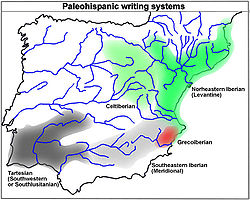
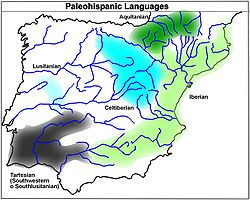
.jpg)
.jpg)
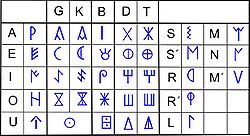
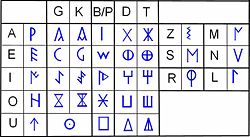
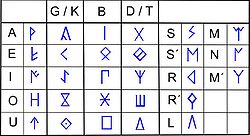
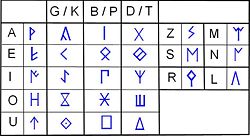
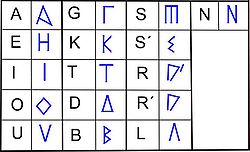
The Paleohispanic scripts are the writing systems created in the Iberian peninsula
Iberian Peninsula
The Iberian Peninsula , sometimes called Iberia, is located in the extreme southwest of Europe and includes the modern-day sovereign states of Spain, Portugal and Andorra, as well as the British Overseas Territory of Gibraltar...
before the Latin alphabet
Latin alphabet
The Latin alphabet, also called the Roman alphabet, is the most recognized alphabet used in the world today. It evolved from a western variety of the Greek alphabet called the Cumaean alphabet, which was adopted and modified by the Etruscans who ruled early Rome...
became the dominant script. Most of them are unusual in that they are semi-syllabic
Semi-syllabary
A semi-syllabary is a writing system that behaves partly as an alphabet and partly as a syllabary. The term has traditionally been extended to abugidas, but for the purposes of this article it will be restricted to scripts where some letters are alphabetic and others are syllabic.-Iberian...
rather than purely alphabetic, despite having developed from the Phoenician alphabet
Phoenician alphabet
The Phoenician alphabet, called by convention the Proto-Canaanite alphabet for inscriptions older than around 1050 BC, was a non-pictographic consonantal alphabet, or abjad. It was used for the writing of Phoenician, a Northern Semitic language, used by the civilization of Phoenicia...
.
Paleohispanic scripts are known to have been used from the 5th century BCE — possibly from the 7th century, in the opinion of some researchers — until the end of the 1st century BCE or the beginning of the 1st century CE, and were the main scripts used to write the Paleohispanic languages
Paleohispanic languages
The Paleohispanic languages were the languages of the pre-Roman peoples of the Iberian Peninsula, excluding languages of foreign colonies, such as Greek in Emporion and Phoenician in Qart Hadast...
. Some researchers conclude that their origin lies solely with the Phoenician alphabet, while others believe the Greek alphabet
Greek alphabet
The Greek alphabet is the script that has been used to write the Greek language since at least 730 BC . The alphabet in its classical and modern form consists of 24 letters ordered in sequence from alpha to omega...
also had a role.
Scripts
The Paleohispanic scripts are classified into three major groups: southern, northern, and Greco-Iberian, with differences both in the shapes of the glyphs and in their values.Inscriptions in the southern scripts have been found mainly in the southern half of the Iberian Peninsula. They represent only 5% of the inscriptions found, and mostly read from right to left (like the Phoenician alphabet). They are:
- the Espanca scriptEspanca scriptThe Espança script is the only complete signary known of the Paleohispanic scripts. It is inscribed on a piece of slate, 48×28×2 cm. This alphabet consists of 27 letters written double...
(known from a single tablet, and the only attestation of an alphetical order); - the Tartessian or Southwestern scriptSouthwest scriptThe Southwest Script or Southwestern Script, also known as Tartessian or South Lusitanian, is a Paleohispanic script used to write an unknown language usually identified as Tartessian...
, also known as South Lusitanian; - the Southeastern Iberian scriptSoutheastern Iberian scriptThe southeastern Iberian script, also known as Meridional Iberian, was one of the means of written expression of the Iberian language, which was written mainly in the northeastern Iberian script and residually by the Greco-Iberian alphabet...
, also known as Meridional.
Inscriptions in the northern scripts have been found mainly in the NE of the Iberian Peninsula
Iberian Peninsula
The Iberian Peninsula , sometimes called Iberia, is located in the extreme southwest of Europe and includes the modern-day sovereign states of Spain, Portugal and Andorra, as well as the British Overseas Territory of Gibraltar...
. They represent 95% of the inscriptions found, and mostly read from left to right (like the Greek alphabet). They are:
- the Northeastern Iberian scriptNortheastern Iberian scriptThe northeastern Iberian script is also known as Levantine Iberian or Iberian, because it is the Iberian script that was most frequently used, and was the main means of written expression of the Iberian language. The language is also expressed by the southeastern Iberian script and by the...
, also known as Levantine;- Dual variant
- Non-dual variant
- the Celtiberian scriptCeltiberian scriptThe Celtiberian script is a paleohispanic script that was the main means of written expression of the Celtiberian language, an extinct Continental Celtic language, also expressed in Latin alphabet...
- Western variant
- Eastern variant.
The Greco-Iberian alphabet
Greco-Iberian alphabet
The Greco-Iberian alphabet is a direct adaptation of an Ionic variant of a Greek alphabet to the specifics of the Iberian language, thus this script is an alphabet and lacks the distinctive characteristic of the rest of paleohispanic scripts that present signs with syllabic value, for the...
was a direct adaptation of the Ionic variety of the Greek alphabet
Greek alphabet
The Greek alphabet is the script that has been used to write the Greek language since at least 730 BC . The alphabet in its classical and modern form consists of 24 letters ordered in sequence from alpha to omega...
, and only found in a small region on the Mediterranean coast in the modern provinces of Alicante
Alicante (province)
Alicante or Alacant is a province of eastern Spain, in the southern part of the Valencian Community. It is bordered by the provinces of Murcia on the southwest, Albacete on the west, Valencia on the north, and the Mediterranean Sea on the east...
and Murcia.
Typology
Excepting the Greco-Iberian alphabet, and to a lesser extent the Tartessian (southwestern) script, Paleohispanic scripts shared a distinctive typology: They behaved as a syllabarySyllabary
A syllabary is a set of written symbols that represent syllables, which make up words. In a syllabary, there is no systematic similarity between the symbols which represent syllables with the same consonant or vowel...
for the stop consonant
Stop consonant
In phonetics, a plosive, also known as an occlusive or an oral stop, is a stop consonant in which the vocal tract is blocked so that all airflow ceases. The occlusion may be done with the tongue , lips , and &...
s and as an alphabet
Alphabet
An alphabet is a standard set of letters—basic written symbols or graphemes—each of which represents a phoneme in a spoken language, either as it exists now or as it was in the past. There are other systems, such as logographies, in which each character represents a word, morpheme, or semantic...
for the rest of consonants. This unique writing system
Writing system
A writing system is a symbolic system used to represent elements or statements expressible in language.-General properties:Writing systems are distinguished from other possible symbolic communication systems in that the reader must usually understand something of the associated spoken language to...
has been called a semi-syllabary
Semi-syllabary
A semi-syllabary is a writing system that behaves partly as an alphabet and partly as a syllabary. The term has traditionally been extended to abugidas, but for the purposes of this article it will be restricted to scripts where some letters are alphabetic and others are syllabic.-Iberian...
.
In the syllabic portions of the scripts, each stop-consonant sign stood for a different combination of consonant and vowel, so that the written form of ga displayed no resemblance to ge, and bi looked quite different from bo. In addition, the original format did not distinguish voiced from unvoiced stops, so that ga stood for both /ga/ and /ka/, and da stood for both /da/ and /ta/.
On the other hand, the continuants (fricative
Fricative consonant
Fricatives are consonants produced by forcing air through a narrow channel made by placing two articulators close together. These may be the lower lip against the upper teeth, in the case of ; the back of the tongue against the soft palate, in the case of German , the final consonant of Bach; or...
sounds like /s/ and sonorant
Sonorant
In phonetics and phonology, a sonorant is a speech sound that is produced without turbulent airflow in the vocal tract; fricatives and plosives are not sonorants. Vowels are sonorants, as are consonants like and . Other consonants, like or , restrict the airflow enough to cause turbulence, and...
s like /l/, /m/, trills
Trill consonant
In phonetics, a trill is a consonantal sound produced by vibrations between the articulator and the place of articulation. Standard Spanish <rr> as in perro is an alveolar trill, while in Parisian French it is almost always uvular....
, and vowels) were written with simple alphabetic letters, as in Phoenician
Phoenician alphabet
The Phoenician alphabet, called by convention the Proto-Canaanite alphabet for inscriptions older than around 1050 BC, was a non-pictographic consonantal alphabet, or abjad. It was used for the writing of Phoenician, a Northern Semitic language, used by the civilization of Phoenicia...
and Greek
Greek alphabet
The Greek alphabet is the script that has been used to write the Greek language since at least 730 BC . The alphabet in its classical and modern form consists of 24 letters ordered in sequence from alpha to omega...
.
Over the past few decades, many researchers have come to believe that one variant of the northeastern Iberian script
Northeastern Iberian script
The northeastern Iberian script is also known as Levantine Iberian or Iberian, because it is the Iberian script that was most frequently used, and was the main means of written expression of the Iberian language. The language is also expressed by the southeastern Iberian script and by the...
, the older one according the archaeological contexts, distinguished voicing in the stop consonants by adding a stroke to the glyphs for the alveolar
Alveolar consonant
Alveolar consonants are articulated with the tongue against or close to the superior alveolar ridge, which is called that because it contains the alveoli of the superior teeth...
(/d/~/t/) and velar
Velar consonant
Velars are consonants articulated with the back part of the tongue against the soft palate, the back part of the roof of the mouth, known also as the velum)....
(/g/~/k/) syllables, creating distinct glyphs for unvoiced /t/ and /k/, and restricting the original glyphs to voiced /d/ and /g/. (This is the so-called dual signary model: see northeastern Iberian script
Northeastern Iberian script
The northeastern Iberian script is also known as Levantine Iberian or Iberian, because it is the Iberian script that was most frequently used, and was the main means of written expression of the Iberian language. The language is also expressed by the southeastern Iberian script and by the...
.) If correct, this innovation would parallel the creation of the Latin letter G by the addition of a stroke to C, which had previously stood for both /k/ and /g/.
Tartessian
The Tartessian script
Southwest script
The Southwest Script or Southwestern Script, also known as Tartessian or South Lusitanian, is a Paleohispanic script used to write an unknown language usually identified as Tartessian...
is typologically intermediate between a pure alphabet and the Paleohispanic semi-syllabaries. Although the letter used to write a stop consonant
Stop consonant
In phonetics, a plosive, also known as an occlusive or an oral stop, is a stop consonant in which the vocal tract is blocked so that all airflow ceases. The occlusion may be done with the tongue , lips , and &...
was determined by the following vowel, as in a semi-syllabary, the following vowel was also written, as in an alphabet. (See Tartessian language
Tartessian language
The Tartessian language is the extinct Paleohispanic language of inscriptions in the Southwestern script found in the southwest of the Iberian Peninsula: mainly in the south of Portugal , but also in Spain . There are 95 of these inscriptions with the longest having 82 readable signs...
for an example.) This redundant typology re-emerged in a few late (2nd and 1st century BCE) texts of northeastern Iberian
Northeastern Iberian script
The northeastern Iberian script is also known as Levantine Iberian or Iberian, because it is the Iberian script that was most frequently used, and was the main means of written expression of the Iberian language. The language is also expressed by the southeastern Iberian script and by the...
and Celtiberian
Celtiberian script
The Celtiberian script is a paleohispanic script that was the main means of written expression of the Celtiberian language, an extinct Continental Celtic language, also expressed in Latin alphabet...
scripts, where vowels were once again written after stop consonants. Some scholars treat Tartessian as a redundant semi-syllabary, with essentially syllabic glyphs followed by the letter for the corresponding vowel; others treat it as a redundant alphabet, with the choice of an essentially consonantal character decided by the following vowel.
This is analogous to the Old Persian cuneiform script
Old Persian cuneiform script
Old Persian cuneiform is a semi-alphabetic cuneiform script that was the primary script for the Old Persian language. Texts written in this cuneiform were found in Persepolis, Susa, Hamadan, Armenia, and along the Suez Canal. They were mostly inscriptions from the time period of Darius the Great...
, where vowels were most often written overtly but where consonants/syllables were decided by the vowel about half the time, and, to a very limited extent, to the Etruscan alphabet, where most syllables based the consonant /k/ shared neither consonant nor vowel letter: Only the combinations CE, CI, KA, and QU were permitted. (This Etruscan convention is preserved in the English, not only in qu for queen, but also the letter names cee, kay, cue/qu.)
Origins
The paleohispanic semi-syllabaries clearly derive ultimately from an alphabetAlphabet
An alphabet is a standard set of letters—basic written symbols or graphemes—each of which represents a phoneme in a spoken language, either as it exists now or as it was in the past. There are other systems, such as logographies, in which each character represents a word, morpheme, or semantic...
or alphabets circulating in the Mediterranean, but it is not known whether that was the Phoenician alphabet
Phoenician alphabet
The Phoenician alphabet, called by convention the Proto-Canaanite alphabet for inscriptions older than around 1050 BC, was a non-pictographic consonantal alphabet, or abjad. It was used for the writing of Phoenician, a Northern Semitic language, used by the civilization of Phoenicia...
alone, or if archaic varieties of the Greek alphabet
Greek alphabet
The Greek alphabet is the script that has been used to write the Greek language since at least 730 BC . The alphabet in its classical and modern form consists of 24 letters ordered in sequence from alpha to omega...
also played a role.
The only known full Paleohispanic signary, on the undated Espanca tablet
Espanca script
The Espança script is the only complete signary known of the Paleohispanic scripts. It is inscribed on a piece of slate, 48×28×2 cm. This alphabet consists of 27 letters written double...
(not completely readable, but clearly related to the southwestern and southeastern scripts), follows the Phoenician/Greek order for the first 13 of its 27 letters: Α Β Γ Δ Ι Κ Λ Μ Ν Ξ Π? Τ. The fact that southern paleohispanic /e/ appears to derive from the Phoenician letter ‘ayin, which gave rise to Greek Ο, while southern paleohispanic /o/ derives from another letter or was perhaps invented, suggests that the development of vowels in paleohispanic semi-syllabaries was independent of the Greek innovation. However, the order of what appears to be /u/ directly after Τ, rather than at the place of , has suggested to some researchers a Greek influence. (In addition, the letter for /e/ in northeast Iberian resembles Greek Ε rather than the southeast Iberian letter.) The two sibilants, S and S', are attested, but there is one sign too few to account for a full 15-sign syllabary and all four of the letters M, M', R, and R' (not all of which can be positively identified with letters from the tablet), suggesting that one of ems or ars shown in the charts to the right is only a graphic variant.
The obvious question about the origin and evolution of these scripts is how a purely alphabetic script was changed into, or perhaps unconsciously reinterpreted as, a partial syllabary. It may be instructive to consider an unrelated development in the evolution of the Etruscan alphabet from Greek: Greek had three letters, Γ, Κ, and , whose sounds were not distinguished in Etruscan. Nonetheless, all three were borrowed, becoming the letters C, K, and Q. All were pronounced /k/, but they were restricted to appear before different vowels — CE, CI, KA, and QU, respectively, — so that the consonants carried almost as much weight in distinguishing these syllables as the vowels did. (This may have been an attempt to overtly indicate the vowel-dependent allophony of Etruscan /k/ with the extra Greek letters that were available.) When the Etruscan alphabet was later adapted to Latin
Latin
Latin is an Italic language originally spoken in Latium and Ancient Rome. It, along with most European languages, is a descendant of the ancient Proto-Indo-European language. Although it is considered a dead language, a number of scholars and members of the Christian clergy speak it fluently, and...
, the letter C stood for both /k/ and /g/, as Etruscan had had no /g/ sound to maintain the original sound value of Greek Г. (Later a stroke was added to C, creating the new Latin letter G.).
Something similar may have happened during the evolution of the Paleohispanic scripts. If writing passed from the Phoenicians through the Tartessians, and the Tartessian language
Tartessian language
The Tartessian language is the extinct Paleohispanic language of inscriptions in the Southwestern script found in the southwest of the Iberian Peninsula: mainly in the south of Portugal , but also in Spain . There are 95 of these inscriptions with the longest having 82 readable signs...
did not have a /g/ or a /d/, that would explain the absence of a distinction between /g/ and /k/, /d/ and /t/ in the southeastern Iberian and later northeast Iberian scripts, despite it being clear that these were distinct sounds in the Iberian language
Iberian language
The Iberian language was the language of a people identified by Greek and Roman sources who lived in the eastern and southeastern regions of the Iberian peninsula. The ancient Iberians can be identified as a rather nebulous local culture between the 7th and 1st century BC...
, as is clearly attested in the Greco-Iberian alphabet
Greco-Iberian alphabet
The Greco-Iberian alphabet is a direct adaptation of an Ionic variant of a Greek alphabet to the specifics of the Iberian language, thus this script is an alphabet and lacks the distinctive characteristic of the rest of paleohispanic scripts that present signs with syllabic value, for the...
and later use of the Latin alphabet. In Tartessian script, vowels were always written after the stop consonants, but they were redundant — or at nearly so — and thus it seems they were dropped when the script passed to the Iberians
Iberians
The Iberians were a set of peoples that Greek and Roman sources identified with that name in the eastern and southern coasts of the Iberian peninsula at least from the 6th century BC...
.
Among the velar consonant
Velar consonant
Velars are consonants articulated with the back part of the tongue against the soft palate, the back part of the roof of the mouth, known also as the velum)....
s, southeastern Iberian ka/ga derives from Phoenician/Greek Γ, ke/ge from Κ, and ki/gi from , while ko/go (perhaps coincidentally) resembles Greek Χ . Phoenician/Greek labial letter Β was the source of ba; the use of Π is uncertain but may have been the source of bi. (If Greek was used as a secondary source, Greek Φ ([pʰ]) would also have been available.) For the alveolars
Alveolar consonant
Alveolar consonants are articulated with the tongue against or close to the superior alveolar ridge, which is called that because it contains the alveoli of the superior teeth...
, Δ was the source of tu/du, Τ of ta/da, and Θ of ti/di.
See also
- Iberian languagesIberian languagesIberian languages is a generic term for the languages currently or formerly spoken in the Iberian Peninsula.- Pre-Roman languages :The following languages were spoken in the Iberian Peninsula before the Roman occupation and the spread of the Latin language.* Aquitanian * Proto-Basque* Tartessian*...
- Iberian Romance languagesIberian Romance languagesThe Iberian Romance languages or Ibero-Romance languages are the Romance languages that developed on the Iberian Peninsula, an area consisting primarily of Spain, Portugal, and Andorra....
- Languages of PortugalLanguages of PortugalThe languages of Portugal are the languages spoken or once spoken in the territory of the country of Portugal.-Modern:Portuguese is practically universal in Portugal, but there are some specificities.thumb|Portuguese dialects of Portugal...
- Languages of SpainLanguages of SpainThe languages of Spain are the languages spoken or once spoken in Spain. Romance languages are the most widely spoken in Spain, of which Spanish is the country's official language...
- Pre-Roman peoples of the Iberian PeninsulaPre-Roman peoples of the Iberian PeninsulaThis is a list of the Pre-Roman peoples of the Iberian peninsula .-Non-Indo-European:*Aquitanians**Aquitani**Autrigones - some consider them Celtic .**Caristii - some consider them Celtic ....

